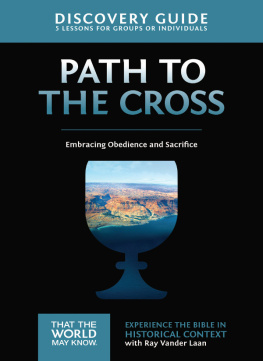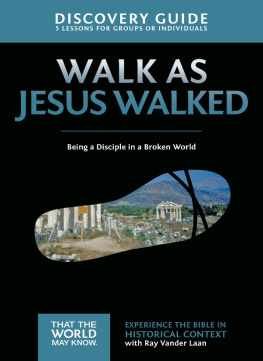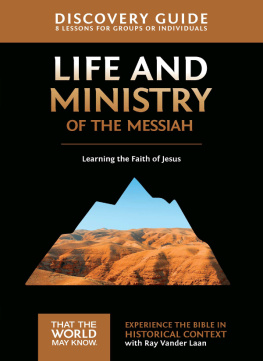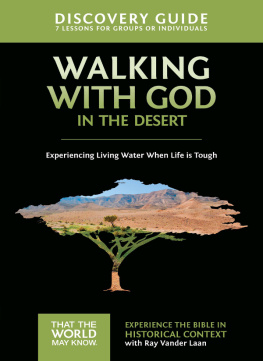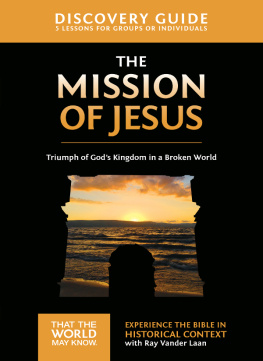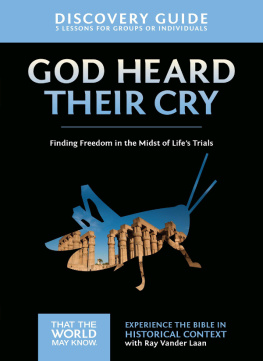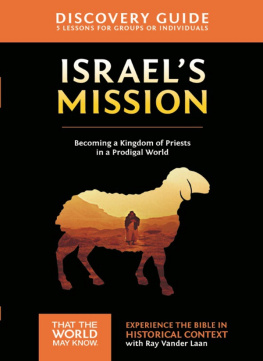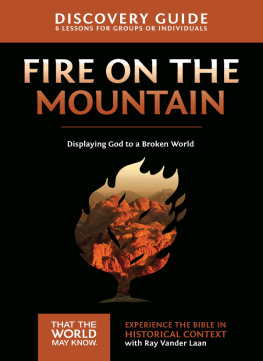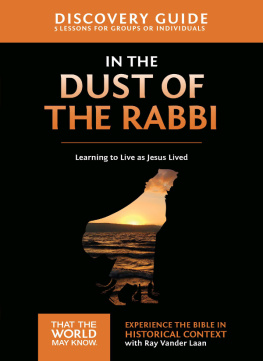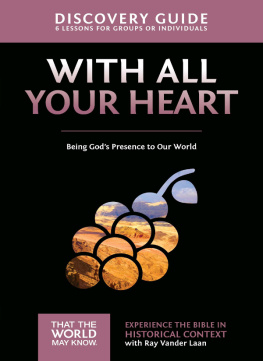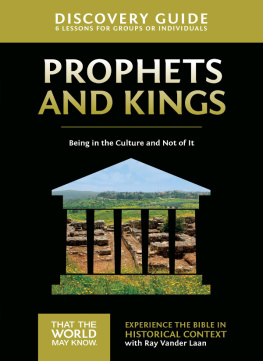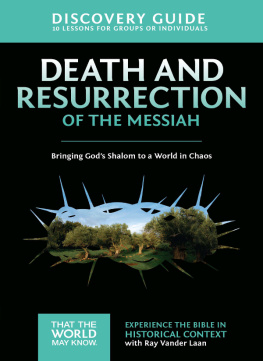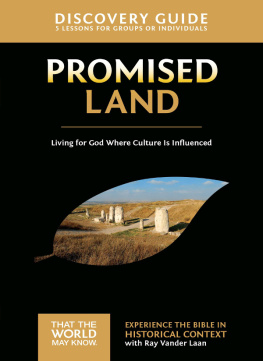That the World May Know with Ray Vander Laan
Volume 1: Promised Land
Volume 2: Prophets and Kings
Volume 3: Life and Ministry of the Messiah
Volume 4: Death and Resurrection of the Messiah
Volume 5: Early Church
Volume 6: In the Dust of the Rabbi
Volume 7: Walk as Jesus Walked
Volume 8: God Heard Their Cry
Volume 9: Fire on the Mountain
Volume 10: With All Your Heart
Volume 11: The Path to the Cross
Volume 12: Walking with God in the Desert
Volume 13: Israels Mission
ZONDERVAN
The Path to the Cross Discovery Guide
Copyright 2010 by Ray Vander Laan
Requests for information should be addressed to:
Zondervan, 3900 Sparks Dr. SE, Grand Rapids, Michigan 49546
Focus on the Family and the accompanying logo and design are federally registered trademarks of Focus on the Family, 8605 Explorer Drive, Colorado Springs, Colorado 80920.
That the World May Know is a trademark of Focus on the Family.
ePub Edition September 2015: ISBN 978-0-310-88059-2
All maps are created by International Mapping.
All photos are courtesy of Ray Vander Laan, Mark Tanis, and Amanda Sorenson.
All illustrations are courtesy of Drew Johnson and Rob Perry.
All Scripture quotations are taken from The Holy Bible, New International Version, NIV. Copyright 1973, 1978, 1984 by Biblica, Inc. Used by permission. All rights reserved worldwide.
Scripture quotations marrked MSG are taken from The Message. Copyright 1993, 1994, 1995, 1996, 2000, 2001, 2002. Used by permission of NavPress Publishing Group.
Any Internet addresses (websites, blogs, etc.) and telephone numbers in this book are offered as a resource. They are not intended in any way to be or imply an endorsement by Zondervan, nor does Zondervan vouch for the content of these sites and numbers for the life of this book.
All rights reserved. No part of this publication may be reproduced, stored in a retrieval system, or transmitted in any form or by any means electronic, mechanical, photocopy, recording, or any other except for brief quotations in printed reviews, without the prior permission of the publisher.
Cover design: DoMoreGood
Cover photography: BiblePlaces.com; Getty Images
Interior design: Ben Fetterley, Denise Froehlich
CONTENTS
Ebook Instructions
In this ebook edition, please use your devices note-taking function to record your thoughts wherever you see the bracketed instructions [Your Notes] or [Your Response]. Use your devices highlighting function to record your response whenever you are asked to checkmark, circle, underline, or otherwise indicate your answer(s).
From the beginning of human history, God the Creator planned to reclaim his world from the chaos of sin. He wanted to restore shalom to his creation, and he chose to use people to accomplish this divine purpose. Through the great exodus of the Hebrews from slavery in Egypt to their home in the Promised Land, God revealed himself to his people, gave them their identity as his chosen people, and instructed them in who he wanted them to become and how he wanted them to live.
The whole story of God reaching into human history and redeeming his chosen people to fulfill his redemptive purpose is recorded in the Torah. Thus the Torah forms the foundation of all future acts of God recorded throughout the Bible. It is Gods blueprint for the role he desires his people to play in the restoration of shalom to his world. It provides the historical, cultural, and redemptive context through which we can better understand the coming of Jesus, the Messiah, and his path to the cross.
God Reclaims His World through the Witness of His People
The Hebrews were to be Gods witness to the world of his plan to reclaim his creation. So the exodus of the Hebrew people from Egypt to the Promised Land was more than a compassionate act of divine deliverance. It was Gods calling of a people to be his treasured possession, kingdom of priests, and holy nation who would put him on display for the whole world to see (Exodus 19:4 6). God, in effect, took Israel as his bride, and lived among them through the years of discipline and testing in the desert in order to mold and shape them to be his faithful witnesses to the world.
The mission of Gods people today is the same one he gave to his ancient people: to live obediently within the world so that through us the world may know that our God is the one true God. For this reason, the great, redemptive acts of God revealed in the exodus are central to the stories of both the Hebrew text (Old Testament) and the Christian text (New Testament).
The historical account of the exodus is central to understanding why many followers of Jesus considered him to be the prophet like Moses the Messiah whom the Lord had promised to send (Deuteronomy 18:17 19; Luke 7:16; 24:19; John 6:14). Jesus often used ideas found in the exodus story, and many of his teachings interpret Moses words in the Torah. Jesus also positioned his redemptive acts against the background of festivals Passover, Unleavened Bread, and First Fruit that are associated with the Hebrews deliverance from Egypt. And at the deepest level, the exodus story not only provides a background for Gods plan to bring Jesus into the world as Messiah, it is one of the first chapters in Gods great redemptive story to restore shalom unity, harmony, order to his broken creation.
For those of us who seek to live as Gods people today, it is essential that we understand these stories as more than ancient history. The stories of the Bible describe God and define the faith walk of his people. Gods people come to know him by what he does, not by attempting to define him with precise doctrine. Gods people come to live the way he desires by remembering, retelling, and reliving his great redemptive acts, not by simply memorizing laws, rules, and regulations.
Despite the many failures of Gods people in fulfilling their role in that story, Gods power has and continues to flow through his flawed (Jesus excepted, of course) human instruments to bring to fruition his plan of redemption. So, like the ancient Hebrews, we need deliverance from the bondage of Egypt. We need to be amazed by Gods power at work at the Red Sea. We need to respond to his voice at Mount Sinai. As we wander through the deserts of our lives, we need to set our feet firmly on the foundation of depending on God and living by his every word. Their story is our story. As we come to know that story and partake of the redemption God offers through his Son, Jesus Christ, we too become part of that ancient story of redemption.
Thus the exodus is a paradigm for our own experience. As Christians today, we can describe our deliverance in similar language because God delivers us by his mercy and the protecting blood of the Lamb Jesus Christ. Without the exodus, we would not be who we are redeemed people delivered by the God of Israel. And without the hardships of the desert experience, we would find it difficult to learn how to live in intimate dependence on his provision and by faithful obedience to his every word.
God Reveals His Story through the Language of Culture
Although the message of Gods story is eternal and unchanging, the writings through which God has revealed himself clearly bear the stamp of time and place. The circumstances and conditions of the people of the Bible are unique to their times. So God has spoken through the context of the cultures in which his people lived. He has used the familiar images of daily life as a means to communicate his message.
For example, when Abraham made a blood covenant with God, he sacrificed animals in a way similar to that of the neighboring Hittites. The staff Moses used symbolized Gods power in ways similar to the stick that represented Pharaohs power in countless statues and carvings throughout Egypt. The tabernacle bears an uncanny resemblance to the war camp of Pharaoh Ramses. The temple Solomon built in Jerusalem is similar in design to the temples of neighboring cultures.
Next page
